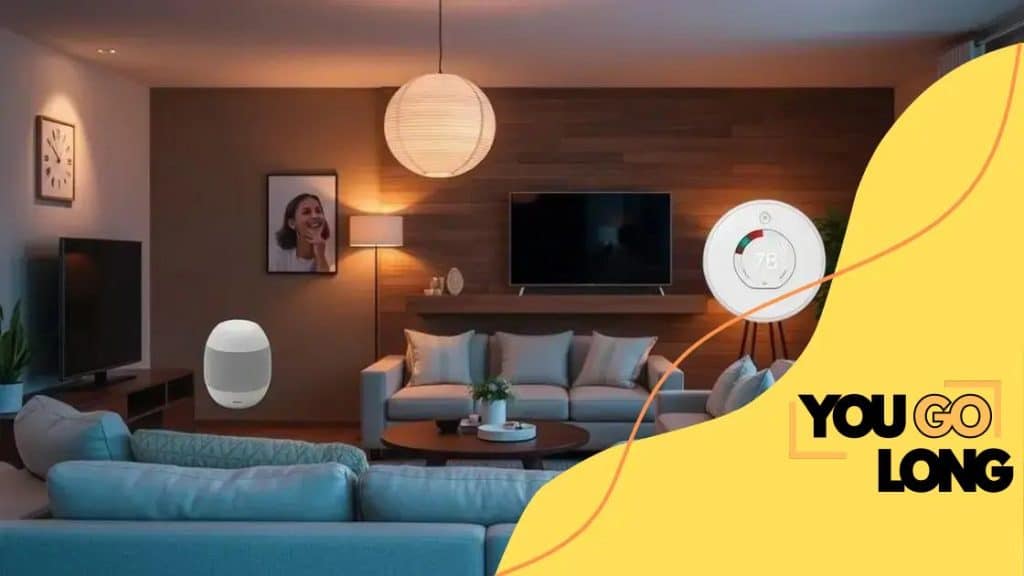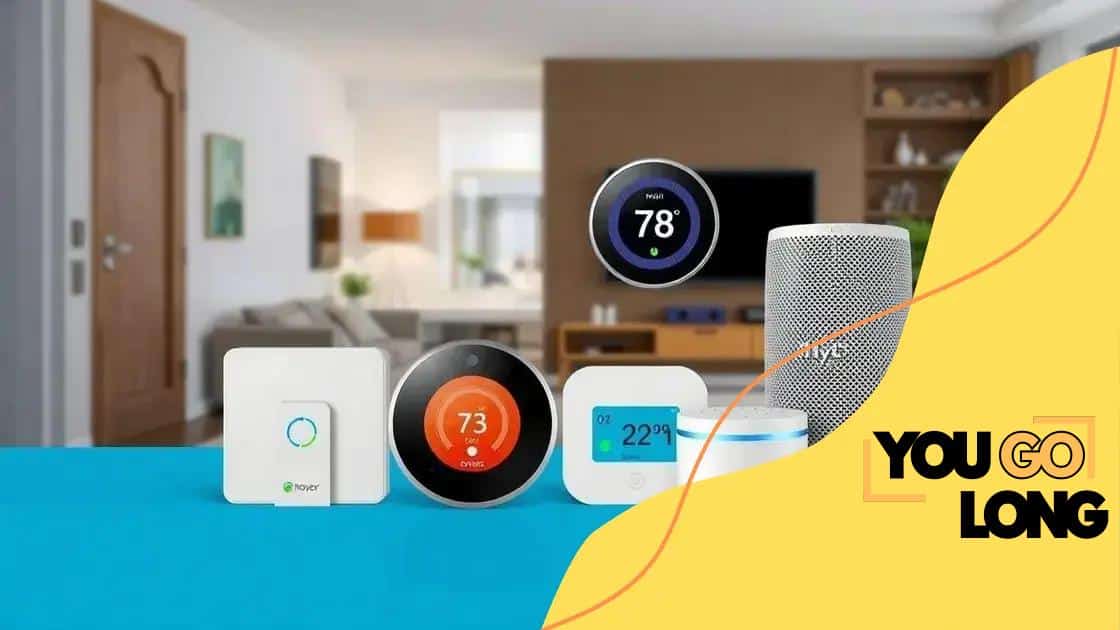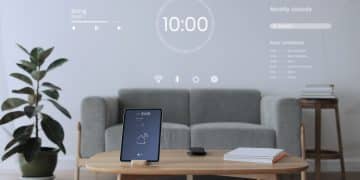How smart home tech is changing daily life

Advertisement
How smart home tech is revolutionizing daily life by enhancing convenience, security, and energy efficiency through seamless integration of devices that adapt to user preferences.
How smart home tech is revolutionizing daily life is changing the way we interact with our environments. Picture waking up to a home that adjusts the temperature, plays your favorite morning playlist, and brews coffee—all without lifting a finger. Intrigued? Let’s explore how these innovations can enhance our day-to-day activities.
The evolution of smart home technology
The journey of smart home technology has been fascinating and transformative. From its humble beginnings to today’s advanced systems, this technology continues to evolve in ways that enhance our daily lives.
Initially, smart home devices were limited to basic automation features. Today, we see a wide array of devices that offer connectivity and automation, turning our homes into intelligent environments.
Advertisement
Key Milestones in Smart Home Development
Several key milestones have shaped the evolution of smart home technology:
- Development of the first programmable thermostats in the 1980s.
- The introduction of Wi-Fi technology in the 1990s, enabling remote access.
- Launch of smart speakers like Amazon Echo in 2014, popularizing voice control.
As the years progressed, the integration of artificial intelligence and the Internet of Things (IoT) has propelled this technology forward. Now, devices can communicate seamlessly with each other, making our lives more convenient and connected.
Modern Features of Smart Homes
Today’s smart homes offer numerous features that enhance comfort and efficiency:
Advertisement
- Smart lighting that adjusts based on time and occupancy.
- Security systems that provide remote monitoring and alerts.
- Appliances that can be controlled via smartphone apps.
This evolution has made it easier than ever to manage various aspects of our homes. Homeowners can now enjoy enhanced energy efficiency, increased security, and a tailored living experience that fits their lifestyle.
With the rapid advancement of technology, it’s exciting to think about the future of smart homes. The ongoing developments will likely bring even more innovations into our daily routines, enhancing the way we interact with our living spaces.
Key benefits of smart home devices
Understanding the key benefits of smart home devices is essential for anyone considering these technologies. These devices have changed how we live, making our homes safer, more efficient, and incredibly convenient.
One of the primary advantages is increased security. Smart home devices, such as cameras and smart locks, allow homeowners to monitor their properties in real-time. With alerts sent directly to smartphones, users can feel more in control and aware of their surroundings.
Convenience and Automation
Smart homes provide unparalleled convenience. Automating everyday tasks frees up valuable time for homeowners. Consider these features:
- Remote control of home appliances through mobile apps.
- Voice activation for hands-free operations.
- Scheduling lights and thermostats based on personal routines.
Such capabilities mean users can adjust their environment effortlessly. No longer do you have to get up to turn off lights or adjust the temperature—everything can be done with a simple voice command or a tap on your smartphone.
Energy Efficiency
Another significant benefit is energy efficiency. Smart devices help manage energy use effectively, which can lead to lower utility bills. For example, smart thermostats learn your routine and adjust the temperature accordingly, saving energy when you’re not home. Additionally, smart lighting systems can turn off automatically when a room is unoccupied.
Over time, these energy savings can contribute to a more sustainable lifestyle. With the planet’s well-being in mind, smart home technology not only benefits individual households but also helps reduce the overall carbon footprint.
Investing in smart home devices means investing in a more secure, efficient, and comfortable living environment. As technology progresses, the advantages of these innovations will only continue to grow.
How to choose the right smart home tech

Choosing the right smart home tech can feel overwhelming due to the variety of options available. Knowing what to look for can make the process easier and ensure that you select devices that fit your lifestyle.
First, consider compatibility with your existing devices. Ensure that new products can connect and interact with your current systems. This will help you avoid frustration later on and lead to a smoother setup experience.
Assess Your Needs
Identifying your specific needs is crucial. Think about what problems you want to solve or what aspects of your home life you’d like to improve. Here are some factors to consider:
- Security: Do you need surveillance cameras or smart locks?
- Convenience: Are you looking for voice-activated assistants or automated lighting?
- Energy savings: Would smart thermostats or energy monitoring devices be beneficial?
It’s important to evaluate how each device can enhance your environment and routines. A clear understanding of your priorities will guide your selections.
Research and Reviews
Researching different brands and models is essential. Look for reviews from other consumers to learn about their experiences. Some features to pay attention to include:
- User interface: Is the app easy to navigate?
- Setup process: How straightforward is the installation?
- Reliability: Does the device perform consistently over time?
Taking the time to read reviews allows you to avoid potential pitfalls and make informed decisions.
Finally, budget plays a crucial role. Determine how much you are willing to spend on smart home tech, and prioritize devices that offer the best value for your needs. With the right approach, choosing the right technology can greatly enhance your daily life. Taking these steps will ensure that you create a smart home that is tailored to your lifestyle.
Integrating smart devices into your routine
Integrating smart devices into your daily routine can greatly enhance comfort and convenience. Understanding how to seamlessly incorporate these technologies into your life is key to maximizing their benefits.
Begin by identifying the areas in your daily activities where automation could save time or effort. Whether it’s adjusting your thermostat, managing lights, or monitoring your security system, smart devices can be tailored to fit your specific needs.
Start with Key Devices
Focus on integrating a few essential smart devices first. Here are some great starting points:
- Smart bulbs allow you to customize lighting and create scenes for different activities.
- Smart speakers can help manage tasks with voice commands and play your favorite music.
- Smart thermostats learn your habits and adjust temperatures automatically, saving energy.
Integrating these devices can create a comfortable home environment with minimal effort.
Create Routines and Automations
Once you have your devices set up, create routines that simplify your daily activities. A morning routine could include:
- Turning on lights gradually to simulate sunrise.
- Adjusting the thermostat to your preferred temperature.
- Playing a news briefing through your smart speaker.
These automations can create a smoother start to your day and save you time on mundane tasks.
As you become more comfortable with your devices, explore advanced features. Many smart home systems allow for integration with third-party applications, giving you even more control over your environment. This flexibility enables you to enhance your routine further, adapting your smart home to your evolving needs.
By taking gradual steps, you can create a connected lifestyle that makes your home work for you, while saving time and increasing convenience.
Future trends in smart home technology
The future trends in smart home technology promise to further enhance our living environments. As technology evolves, we can expect innovative developments that will make our homes even smarter and more connected.
One significant trend is the increased integration of artificial intelligence. AI will make smart devices more intuitive, learning from user behaviors to offer personalized experiences. Imagine a home that anticipates your needs, adjusting lighting and temperature before you even enter a room.
Improved Interconnectivity
Another promising trend is enhanced interconnectivity between devices. The Internet of Things (IoT) is set to expand, allowing appliances from different manufacturers to work together seamlessly. This gives users more control over their home environment and greater efficiency.
- Devices will communicate in real-time, leading to better energy management.
- Smart home systems will be easier to set up and manage via centralized apps.
- Increased compatibility will allow for creative combinations of devices.
As systems become more integrated, managing your home will be simpler and more effective.
Emphasis on Sustainability
Another key trend is the focus on sustainability. Smart technology is increasingly being designed to reduce energy consumption and minimize environmental impact. Features that promote energy efficiency are becoming standard in many devices:
- Solar-powered devices and energy-efficient appliances.
- Smart irrigation systems that adjust water use based on weather conditions.
- Devices that provide users with insights into their energy consumption patterns.
This not only benefits the environment but also helps users save money on utility bills.
Finally, advancements in security technology will continue to be a top priority. As smart homes become more widespread, the need for robust security measures will increase. Innovations in this area may include biometric access, AI-driven security alerts, and enhanced surveillance capabilities to ensure the safety of your home.
FAQ – Frequently Asked Questions about Smart Home Technology
What are the main benefits of smart home technology?
Smart home technology offers increased security, energy efficiency, convenience, and improved interconnectivity among devices.
How can I start integrating smart devices into my home?
Start with essential devices like smart bulbs, thermostats, and speakers. Focus on one area at a time to make the transition easier.
Are smart home devices compatible with each other?
Many smart home devices are designed to be compatible with one another, especially those that follow the same smart home protocols or ecosystems.
What can I expect from the future of smart home technology?
The future includes advancements in AI integration, better security features, and increased focus on sustainability, making homes even smarter.





